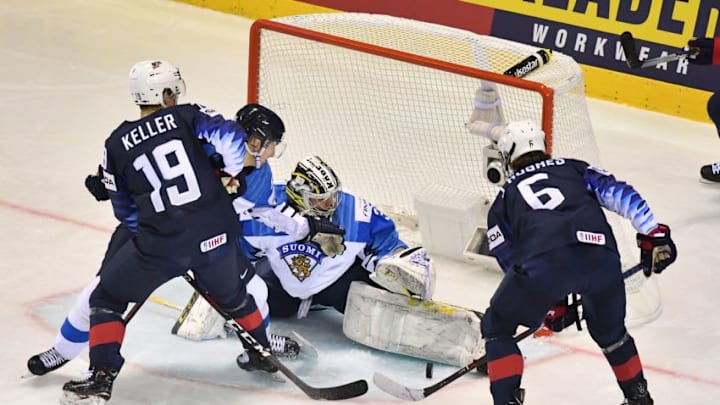
It was a dream match-up for New York Rangers fans. Finland vs. the USA at the World Championships and the chance to see the top two prospects in the world playing against each other.
For the New York Rangers, they didn’t learn anything they didn’t know from Monday’s game between Finland and the United States. For the New Jersey Devils, the game made the choice just a little more difficult.
Both prospects were scoreless, but one of the two players had a much more dynamic game and it was that performance that will put more pressure on the Devils to make the right call in June.
Team USA won the game, 3-2 when Dylan Larkin scored at the 3:47 mark of the 3v3 overtime. Ranger defenseman Brady Skjei scored the first goal for the USA and was named the Team USA player of the game. Skjei scored 50 seconds into the game.
A goal so smooth is must be that Skjei butter #USAFIN #IIHFWorlds pic.twitter.com/rAsgd8KYrK
— IIHF (@IIHFHockey) May 13, 2019
Skjei played 21:48 on the second defense pairing.
Kakko’s game
This game displayed the biggest difference between the two players, a difference that the TSN announcers kept emphasizing. Kaapo Kakko is an 18-year old who has been playing with grown men in the SM-Liiga in Finland. He has established himself as one of the top players on a team with only two NHL players.
Juho Lammikko (Florida) and Henri Jokiharju (Chicago) have a combined 70 NHL games under their belt and they have scored a grand total of zero goals. These are not household names.
Kakko played 18:46, the most minutes of any Finnish player and had a team leading six shots. He was dominant at times and made one pass that should have resulted in a goal. His strength is obvious and he outmuscled Ryan Suter twice, maintaining possession and driving the offense. Suter is the top defenseman for Team USA and Kakko had little difficulty in fending him off.
He didn’t score, but was on the ice for the Finn’s second period power play goal, planting his big body in front of the net and distracting Cory Schneider.
A nice dish from Manninen to Ojamaki ties the game for @leijonat #USAFIN #IIHFWorlds
— IIHF (@IIHFHockey) May 13, 2019
Stay up to the minute with game action on the IIHF App:
https://t.co/PDQtNtuJxc
▶️ https://t.co/yImldTg3TU pic.twitter.com/6zJas2Yj4G
Kakko was held scoreless for the first time in three games, but was on the ice for both Finland goals.
Hughes’ game

Jack Hughes played 9:24, centering the fourth line. He didn’t have much of an impact on the game, but he didn’t make any mistakes either. He didn’t get any shots on goal and did get some icetime during the overtime.
Hughes turns 18 tomorrow and gets to shed the birdcage helmet and go to a visor. He is growing up, but on a team of NHL stars, he is still a prospect. Whereas Kakko is on a team with virtually no NHL players, Jack Hughes and Adam Fox are the only two players on Team USA who have not seen any action in the NHL.
Kakko vs. Hughes
The TSN announcers kept stating that they believe that the draft order will not change, that Hughes will go first and Kakko second. Despite Kakko’s gaudy stats and impressive performance at the tournament so far, there is no reason to believe that they are wrong.
It’s a simple fact that Kakko is more NHL-ready than Hughes and their careers won’t be able to be judged until both players have been in the league for several years. Kakko looks to be the quintessential power forward while Hughes is a skilled playmaker. While Kakko may be more advanced today, in five years the tables may turn.
There was one magical shift in the game when both Hughes and Kakko were on the ice and it was during that shift that the difference between the two players was most obvious. Hughes just looked smaller next to Kakko and when they came together along boards, it was Hughes who ended up on the ice and Kakko with the puck. It was picked up quickly by a Finnish newspaper on Twitter:
The translation is that Kakko dominated Jack Hughes, clearly a biased opinion from the Finnish publication.
As much as it is fun to look at these games as decision makers, in a game when Kakko played more minutes in the second period alone than Hughes did in the entire game, this game won’t really make a difference.
We cannot forget that both the Devils and the Rangers have been scouting both of these players for many months. That due diligence is going to count a lot more than a preliminary round game at the World Championships.
